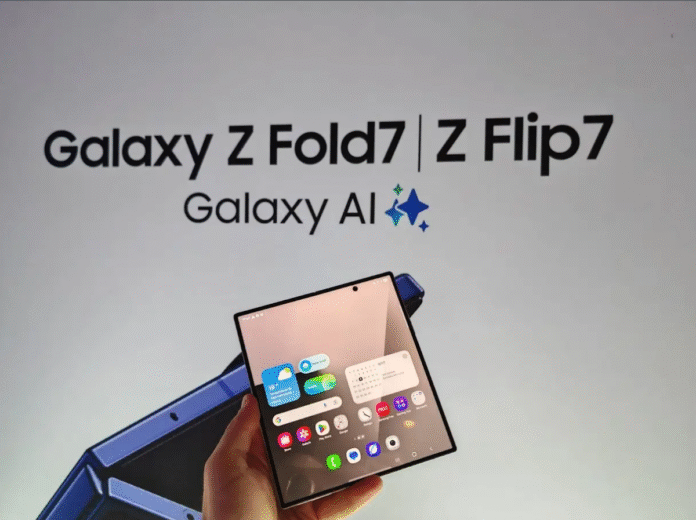Samsung Market Share Surge Challenges Apple in U.S. Smartphone Battle
Samsung market share surge is shaking up the U.S. smartphone industry, where Apple has long held dominance. With the rise of foldable phones and a fresh lineup of premium devices, Samsung has managed to capture attention, boost sales, and expand its influence. Recent reports suggest that the balance of power between Apple and Samsung is once again shifting, reviving a rivalry that defined the smartphone market more than a decade ago.

The Return of an Old Rivalry
Back in 2014, Samsung’s bold move to release larger-screen smartphones pushed Apple into unfamiliar territory. Until then, iPhones stuck to smaller displays, but consumer demand for bigger screens was undeniable. When Apple finally launched the iPhone 6, it reestablished its dominance.
Fast forward to 2025, and the competition has reignited this time, driven by foldable technology and innovative form factors. Samsung market share surge is now backed by a diversified product line and significant consumer interest, while Apple faces growing turbulence.
Samsung Market Share Surge by the Numbers
According to Canalys, Samsung’s market share in the U.S. jumped from 23% to 31% in Q2, while Apple’s share slipped from 56% to 49%. This marks the first notable decline for Apple in over a decade.
Globally, Apple remains strong, but Samsung’s flexibility in pricing and form factor innovation is giving it an edge. Meanwhile, Apple’s stock has fallen 7.5% in 2025, whereas Samsung’s stock surged 35%, a clear sign of shifting investor confidence.
Foldable Phones Drive the Samsung Market Share Surge
Samsung’s Galaxy Z Fold 7 and Galaxy Z Flip are at the heart of this transformation. The Z Fold 7 doubles as a tablet, while the Z Flip revives the retro flip design with modern smartphone functionality.
The buzz around foldables isn’t just about looks. Samsung’s latest models have passed intense durability tests, including a viral livestream where one user folded the Z Fold 7 over 200,000 times. This clip alone racked up 15 million views on YouTube, reflecting the strong social media traction.
According to Sprout Social, Samsung’s premium devices were mentioned over 50,000 times on social platforms in July, with 83% positive or neutral sentiment a strong indicator of consumer approval.

Pricing Strategy: Samsung vs Apple
Another major factor behind Samsung market share surge is its wide product range. Samsung smartphones in the U.S. now span from $650 to $2,400, appealing to nearly every budget segment.
Apple, on the other hand, sticks to a tighter pricing bracket of $829 to $1,599, focusing on fewer premium options. Analysts suggest that Samsung’s ability to serve both low-end and high-end markets gives it a crucial edge.
Apple’s Upcoming Response
Apple isn’t staying idle. Analysts, including JPMorgan Chase’s Samik Chatterjee, predict Apple could unveil its first foldable iPhone as part of the iPhone 18 lineup in 2026. A slimmer iPhone, rumored to launch next month, is also expected to compete with Samsung’s Galaxy Edge.
Apple’s strategy has always been to wait until new technology matures before launching products, ensuring consumer trust in quality. However, with Samsung market share surge gaining momentum, Apple may need to move faster than usual.
Samsung Market Share Surge and AI Integration
Artificial Intelligence is also fueling Samsung’s momentum. Its foldables seamlessly integrate Google’s Gemini AI, offering advanced features beyond what Apple’s Siri currently delivers. For example, Samsung’s larger displays make AI tools like circle-to-search more productive, allowing users to multitask between apps without disruption.
Apple, meanwhile, has delayed its next-generation Siri until 2026. While Apple’s brand loyalty remains strong, analysts warn that prolonged delays in AI integration could slow iPhone adoption.
Durability and Consumer Trust
One of the biggest barriers for foldables has been durability. Samsung’s early folding models in 2019 struggled with screen creases and reliability issues. But the Galaxy Z Fold 7 marks a turning point.
Drew Blackard, VP of Mobile Product Management at Samsung Electronics America, confidently stated:
“There really are no longer trade-offs towards owning a foldable device.”
Pre-orders for the Z Fold 7 were up 25% compared to previous models, with sales nearly 50% higher than its predecessor. This demonstrates strong consumer trust and signals that foldables are finally ready for mainstream adoption.

The Bigger Picture: What’s Next for Smartphones?
The Samsung market share surge highlights a broader trend, consumers are craving innovation beyond the traditional glass-and-metal slab design. With AI integration, foldable screens, and wearable alternatives, the next wave of smartphones could look very different.
Apple is rumored to explore new devices beyond iPhones, while Samsung continues experimenting with form factors. The battle is no longer just about performance; it’s about who can redefine the future of mobile technology first.

